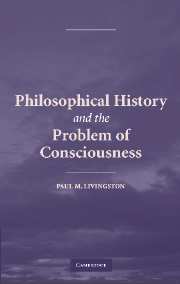Book contents
- Frontmatter
- Contents
- Preface
- Acknowledgments
- 1 Introduction: Philosophical History and the Problem of Consciousness
- 2 Structuralism and Content in the Protocol Sentence Debate
- 3 Husserl and Schlick on the Logical Form of Experience
- 4 Ryle on Sensation and the Origin of the Identity Theory
- 5 Functionalism and Logical Analysis
- 6 Consciousness, Language, and the Opening of Philosophical Critique
- Notes
- Works Cited
- Index
2 - Structuralism and Content in the Protocol Sentence Debate
Published online by Cambridge University Press: 16 July 2009
- Frontmatter
- Contents
- Preface
- Acknowledgments
- 1 Introduction: Philosophical History and the Problem of Consciousness
- 2 Structuralism and Content in the Protocol Sentence Debate
- 3 Husserl and Schlick on the Logical Form of Experience
- 4 Ryle on Sensation and the Origin of the Identity Theory
- 5 Functionalism and Logical Analysis
- 6 Consciousness, Language, and the Opening of Philosophical Critique
- Notes
- Works Cited
- Index
Summary
Beginning in the 1920s, the philosophers of the Vienna Circle sought to explain the possibility of scientific knowledge with a new theory of meaning that joined the empirical content of experience to the formal structure of logical inference and derivation. Drawing upon the logical and mathematical tools recently developed by Frege, Hilbert, Russell, and Wittgenstein, proponents of what might be called the structuralist theory of meaning set the private, ineffable, or incommunicable content of subjective experience off against the linguistic form of intersubjective communication and conceptual articulation. The theory drew its ultimate conceptual warrant from the method of logical analysis that inaugurated the analytic tradition itself, but it took specific shape in response to the need to account semantically for the contribution of experience to empirical meaning within a unified, empiricist epistemology of scientific knowledge. Its conception of meaning as ultimately structural, and its assertion of a link between this conception and the possibility of objectivity, would continue to orient the theories and projects of analytic philosophers long after the breakup of the Circle in 1935. But in this conception lay, as well, the ultimate seeds of the downfall of the Circle's originally unified theoretical project. The project came to grief when the philosophers of the Circle could not agree about the logical form of basic observational or “protocol” sentences, sentences capturing the immediate observations to which, the members of the Circle supposed, all empirical knowledge must ultimately trace.
- Type
- Chapter
- Information
- Philosophical History and the Problem of Consciousness , pp. 29 - 76Publisher: Cambridge University PressPrint publication year: 2004



